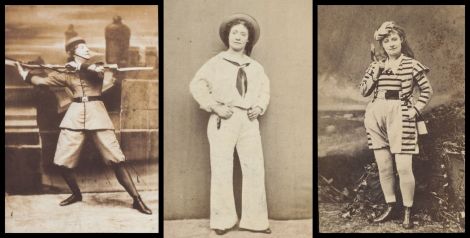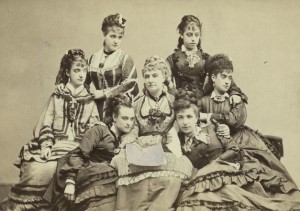Lydia Thompson, the father of all drag kings
By Bobster
When Lydia Thompson and her “British Blondes” first stepped onto the New York stage in 1868, audiences went wild. Not only were they being introduced to a rowdy English version of the entertainment called burlesque, but here were women in masculine clothes playing men’s roles. The city had never seen anything quite like it.

Photos from the Victoria & Albert Museum, London
Today’s drag kings are spiritual heirs of Lydia Thompson, who became one of the biggest stars on both sides of the Atlantic in her era. Born in 1838, the daughter of a London public-house keeper, she began dancing professionally as a teenager and performed across Europe. “She was charming to look at, a good singer, a really clever dancer, and the life and soul of the scene while on the stage,” according to author Errol Sherson.
Thompson was still in her 20s when she began performing in drag regularly. She played Max in a burlesque of Weber’s Der Freischütz (1866), as Prince Buttercup in The White Fawn, as Massaroni in the burlesque The Brigand, and as Prince Florizel in another burlesque, Perdita.
Having attained fame on the London stage, she crossed the ocean to conquer America. “The eccentricities of pantomime and burlesque – with their curious combination of comedy, parody, satire, improvisation, song and dance, variety acts, cross-dressing, extravagant stage effects, risqué jokes and saucy costumes – while familiar enough to British audiences, took New York by storm,” writes Signe Hoffos.

According to GLBTQ.com, in the mid-nineteenth century this theatrical form was associated primarily with parody of high culture through puns, wordplay, and nonsense.
“Burlesque in the United States was transformed by the tour of Lydia Thompson’s British Blondes in the late 1860s. This troupe continued to use the standard formulae of burlesque, but they infused the form with sex. The actresses in this predominantly female troupe dressed in scanty costumes that showed their legs to the audience. Burlesque always included cross-dressed roles in keeping with the topsy-turvy world of this form,” writes Gillian Rodger of GLBTQ.com.
“Critics were disturbed by watching a woman who was clearly identifiable as such striding, swearing, spitting, and otherwise acting like a man,” she adds.
Were some of these cross-dressing women lesbians? While it’s difficult to be certain, “there was a clear recognition by theater folks of this period that some performers were in same-sex or untraditional relationships. This recognition can be seen in snippets of gossip columns in theatrical newspapers that make oblique, usually snide, references to performers’ private lives,” Rodger writes.

Lydia Thompson and some of her troupe. Photo from the New York Public Library.
There’s nothing to indicate that Thompson herself was queer. She is believed to have married twice, and had a daughter with her first husband. She remarried after her husband was killed in an accident. Thompson later separated from her second husband.
According to John Kenrick, author of Burlesque, the arrival of Thompson and her troupe “became New York’s biggest theatrical sensation. Their first hit was Ixion (1868), a mythological spoof that had women in revealing tights playing men’s roles. In the Victorian age, when proper women went to great lengths to hide their physical form beneath bustles, hoops and frills, the idea of young ladies appearing onstage in tights was a powerful challenge.
“Underdressed women playing sexual aggressors, combining good looks with impertinent comedy – in a production written and managed by a woman? Unthinkable! No wonder men and adventurous wives turned out in droves, making Thompson and her ‘British blondes’ the hottest thing in American show business.”
Demand for tickets was such that Ixion soon moved to Broadway’s most prestigious musical house, Niblo’s Garden. All told, Thompson’s first New York season grossed over $370,000, according to Kenrick.
Another theater historian, Kurt Ganzl, notes that “the company thrived on a slightly scandalous reputation which Lydia and her managers fostered finely, winning nationwide publicity with the tales of her `lesbian attacker’ and of her public horsewhipping of the ungentlemanly proprietor of the Chicago Times who had published a piece reflecting on the virtue of the ‘blondes’.”
After the phenomenal success of the New York performances, Lydia’s troupe embarked upon an American tour that was to last for the next six years. Everywhere they went, they met with the same enthusiastic reception, tempered here and there with a voice of dissent, according to writer Bob Moulder.

Lydia Thompson in some of her roles. Photo from the New York Public Library.
Thompson and her troupe finally returned to England in 1874, and she resumed her starring roles in London and provincial productions. Once again, she specialized in drag roles, playing Robinson Crusoe and Bluebeard, among others.
America was to welcome her back several times during the next twenty years, but it was this first visit which fixed her in the imagination of the American public, writes Bob Moulder. “Her breeches’ roles, her eating habits and her devil-may-care assertiveness offered a new, more independent model of femininity to American women.
“One would be hard put to think of a model for Lydia Thompson, but there can be no denying that she set a precedent for generations to come. In this respect, more than one commentator has traced her influence to the early stars of Hollywood, citing Mae West as perhaps not the least of her imitators.”
Lydia Thompson died in London in 1908, at the age of 70.
About Bobster
Bobster is a freelance writer living in Honolulu, Hawaii. His Flickr account is here.
Category: faces 11 comments »





June 16th, 2009 at 2:04 pm |
great article.. very informative.. enjoyed reading it.
[Reply]
June 17th, 2009 at 11:39 pm |
"although burlesque is now most often associated with seedy strip shows and low comedy"
Have you examined the modern burlesque scene at all? I'm amazed that a website like this could completely overlook the huge burlesque revival and shift in attitudes over the past few years. "Cinema", "Dutch Weismanns' Follies" , and "The Velvet Hammer Burlesque"- look them up.
And secondly, as a sex worker, I find characterizing strip shows as "seedy" to be massively offensive. Fewer broad generalizations and some actual research, please.
[Reply]
sarahdopp replied:
June 18th, 2009 at 2:17 am
Eek! Thank you so much for commenting, Mish! That was a total editing oversight on my part and not at all representative of our perspective. Living in San Francisco, I have a BUNCH of friends who dance burlesque and it's a gorgeous and classy form of art. (I also have a handful of friends who are sex workers, and there's nothing seedy about a good strip club.)
REALLY sorry that got in there. I'm gonna take it out right now, and will leave this comment thread up so anyone who's curious can see what happened.
Thank you again.
[Reply]
Mish replied:
June 18th, 2009 at 7:18 pm
Thanks for the quick response Sarah- I really appreciate your taking the time to address this. I'm a big fan of Genderfork, and you've really increased my respect for you and it by responding to my concern like this.
[Reply]
IdentityTBD replied:
June 19th, 2009 at 1:15 am
Mish – Let me add my apologies as well. I am the site editor–and a fan of contemporary burlesque. I should have read the piece with greater sensitivity and edited with a heavier hand.
Mish replied:
June 20th, 2009 at 2:05 am
Thank you- again, my appreciation for your quick response and editing. It really means a lot to know one of my favorite sites has such respect for its readers.
June 19th, 2009 at 9:12 am |
The sentence was accurate as originally written. While I'm glad that burlesque is enjoying a renaissance of late, the public perception of it as a somewhat disreputable form of entertainment hasn't changed all that much. Hopefully, attitudes will evolve in places outside of San Francisco as time goes by.
[Reply]
September 29th, 2009 at 6:12 am |
An interesting read but there is more to consider. What about Eliza Vestris? She was a breeches role burlesque star long before Lydia was born. Furthermore, neither Eliza or Lydia are really drag kings per se – it was Vesta Tilley who most likely wins this accolade as she wore padding etc to actually look like a man – not dress as a ‘principal boy’.
Just some thoughts…
[Reply]
March 26th, 2010 at 7:29 pm |
I very much beg to differ with your comment “There’s nothing to indicate that Thompson herself was queer.” All you use to prove that is that she was married twice, and had a child. I have been married (to the opposite gender) twice, and have two children, but I am bisexual and genderqueer, am a bi activist, and spend nearly all the time I am not at work on bi/queer activism. I DEFINITELY consider myself queer, and find your comments to be very dismissive of bisexuals and the genderqueer population.
It is interesting, but about half of the people who come to my bisexual support group are also genderqueer, and most of them cross-dress. One is not as aware when a woman cross-dresses, because it’s “normal” these days for a woman to wear pants. Lydia could have been genderqueer, and expressing her male side by Drag Kinging.
[Reply]
March 26th, 2010 at 8:59 pm |
I think you misunderstood my comment, Estraven. I meant simply that the existing evidence indicates she led a heterosexual life off the stage; i.e. she married men and there are no stories of romantic associations with women. This isn’t absolute proof that she was heterosexual, of course, but I never claimed that.
[Reply]
February 21st, 2011 at 7:34 pm |
Hi Bobster! I’m sorry you left flickr. I’ll miss you. Your Twisted Adverts were always my favorite way to cheer up a rough day. Good luck to you.
Mary (Gebodogs)
[Reply]